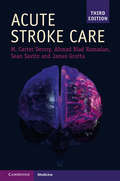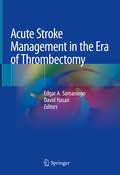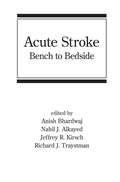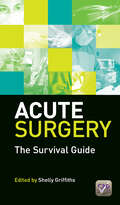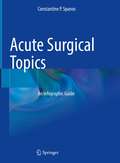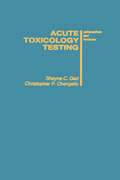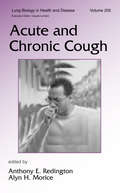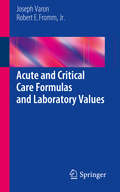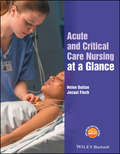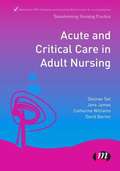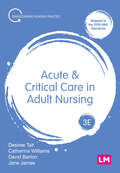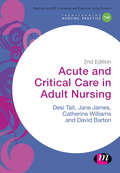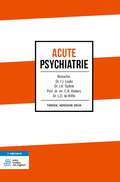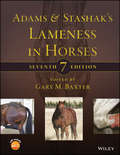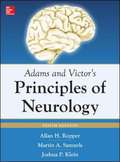- Table View
- List View
Acute Stroke Care
by Ken Uchino Jennifer Pary James C. GrottaYou have just encountered a possible stroke patient. You ask yourself: what should I do first? How do I know it is a stroke? Is it too late to reverse the damage? How do I do the right things in the right order? This book will help you answer these critical questions. It provides practical advice on the care of stroke patients in a range of acute settings. The content is arranged in chronological order, covering the things to consider in assessing and treating the patient in the emergency department, the stroke unit and then on transfer to a rehabilitation facility. All types of stroke are covered. This new edition provides updated information from recently completed clinical trials and added information on endovascular therapy, hemicraniectomy for severe stroke, DVT prophylaxis and stroke prevention. A comprehensive set of appendices contain useful reference information including dosing algorithms, conversion factors and stroke scales.
Acute Stroke Care
by Ken Uchino Jennifer Pary James GrottaYou have just encountered a possible stroke patient. You ask yourself: what should I do first? How do I know it is a stroke? Is it too late to reverse the damage? How do I do the right things in the right order? This book will help you answer these critical questions. It provides practical advice on the care of stroke patients in a range of acute settings. The content is arranged in chronological order, covering the things to consider in assessing and treating the patient in the emergency department, the stroke unit and then on transfer to a rehabilitation facility. All types of stroke are covered. This new edition provides updated information from recently completed clinical trials and added information on endovascular therapy, hemicraniectomy for severe stroke, DVT prophylaxis and stroke prevention. A comprehensive set of appendices contain useful reference information including dosing algorithms, conversion factors and stroke scales.
Acute Stroke Care: A Manual From The University Of Texas - Houston Stroke Team (Cambridge Manuals in Neurology)
by James Grotta Sean I. Savitz Ahmad Riad Ramadan Mary Carter DennyYou have just encountered a possible stroke patient. You ask yourself: what should I do first? How do I know it is a stroke? Is it too late to reverse the damage? This book provides integral assistance in answering these critical questions. All content is arranged in chronological order, covering all considerations in assessing and treating patients in the emergency room, stroke unit, and rehabilitation facilities. This new edition offers readers the latest information on stroke treatment, and features brand new chapters on stroke radiology, endovascular therapy, the uncommon causes of stroke, cerebral venous thrombosis, stroke prevention, and the transition to outpatient care. The comprehensive set of appendices contains useful reference information, including dosage algorithms, conversion factors, and stroke scales.
Acute Stroke Management in the Era of Thrombectomy
by Edgar A. Samaniego David HasanThis book contains a compilation of the revolution of mechanical thrombectomy (MT) in the treatment of strokes. The initial chapters summarize information about the best medical management of acute ischemic stroke, imaging modalities and patient selection for MT. The book then focuses on the nuances of MT, providing detailed information about the best approaches for anesthesia during MT, access, intra-arterial thrombolysis, recent devices and catheters and technical pitfalls of MT. A specific chapter is dedicated to MT in the venous system. This is followed by a chapter about the most common complications of MT and post-procedural care of these patients. The last chapter covers different aspects of acute stroke care and MT in the developing world. The authors of this book comprise of a multidisciplinary group of world experts in the field and were encouraged to include teaching cases to deliver a book with a practical approach.Acute Stroke Management in the Era of Thrombectomy is intended for all healthcare providers who care for patients with stroke; with special emphasis for the proceduralists who are interested in technical tips to improve outcomes and minimize complications.
Acute Stroke Nursing
by Jane Williams Caroline Watkins Lin PerryStroke is a medical emergency that requires immediate medical attention. With active and efficient nursing management in the initial hours after stroke onset and throughout subsequent care, effective recovery and rehabilitation is increased. Acute Stroke Nursing provides an evidence-based, practical text facilitating the provision of optimal stroke care during the primary prevention, acute and continuing care phases.This timely and comprehensive text is structured to follow the acute stroke pathway experienced by patients. It explores the causes, symptoms and effects of stroke, and provides guidance on issues such as nutrition, continence, positioning, mobility and carer support. The text also considers rehabilitation, discharge planning, palliative care and the role of the nurse within the multi-professional team. Acute Stroke Nursing is the definitive reference on acute stroke for all nurses and healthcare professionals wishing to extend their knowledge of stroke nursing.Evidence-based and practical in style, with case studies and practice examples throughoutEdited and authored by recognised stroke nursing experts, clinicians and leaders in the field of nursing practice, research and educationThe first text to explore stroke management from UK and international perspectives, and with a nursing focus
Acute Stroke: Bench to Bedside (Neurological Disease and Therapy)
by Jeffrey R. Kirsch Anish Bhardwaj Nabil J. Alkayed Richard J. TraystmanAs the third leading cause of death in the United States, stroke accounts for one in every fifteen deaths and is the major cause of disability in the country. Compiled by a renowned editorial team, this reference bridges the gap between basic science and patient care protocols, and collects 43 expertly written chapters that range from laboratory-ba
Acute Surgery: The Survival Guide
by Shelly GriffithsOut-of-hours, junior doctors and medical students often find themselves covering specialties and subspecialties out-of-hours that they have little or no experience in. Acute Surgery: The Survival Guide is the only completely up-to-date pocketbook on the market providing a clear plan for the management of common acute presentations in a concise, easy to manage format. It promotes confidence in dealing with the daunting range of acute presentations and provides a fail-safe approach to patient management plans in general surgery, vascular surgery, urology, EN T surgery and orthopaedics. It also contains vital advice on management of commonly seen ward issues and the approach to trauma patients. This handy guide offers clear, practical advice for junior doctors, medical students, foundation doctors and core surgical trainees. It is also highly recommended for nontraining doctors, in-house and senior house officers.
Acute Surgical Topics: An Infographic Guide
by Constantine P. SpanosThis book aims to familiarize readers with the most common acute surgery topics encountered in clinical practice and is unique in its use of infographics. It will be used in clinical rotations in surgery as a supplement to the knowledge gained, and will also provide instructors with a complementary tool, offering a wide-ranging guide to general aspects of acute surgery, with some hints on gynecologic and urologic emergencies. The book is intended to provide medical students and junior residents in medicine or surgery with a comprehensive and up-to-date overview of the most relevant operative techniques.
Acute Toxicology Testing: Perspectives and Horizons
by Shayne C. Gad Christopher P. ChengelisAcute toxicology testing constitutes the first line of defense against potentially dangerous chemicals. This book provides a detailed presentation of protocols for each of the common designs, reviews their development and objectives, discusses the types of data they generate, and examines the current status of alternative test designs and models. F
Acute Trauma Care in Developing Countries: A Practical Guide
by Kajal Jain and Nidhi BhatiaThis evidence-based manual highlights the early management of acutely injured trauma victims arriving in emergency triage areas. It caters to the needs of developing nations in pre-hospital as well as in-hospital emergency trauma care and provides clear practical guidelines for the management of victims of major trauma. The book covers basic principles for managing a crashing trauma patient, followed by effective treatment by different sub-specialty. Input from experienced anaesthesiologists, intensivists, orthopaedics, vascular surgeons, plastic surgeons, and radiologists, make this book a gold standard for good practice for professionals. Key Features:• Covers all aspects of acute trauma, including orthopaedics, vascular surgery, plastic surgery, neurosurgery, burns and radiology• Elaborates on damage control resuscitation and management of initial and life-threatening injuries, useful for professionals dealing with trauma patients in the emergency area• Guides in initial fluid therapy and pain control along with initial patient resuscitation
Acute and Chronic Cough (Lung Biology in Health and Disease)
by Alyn H. Morice Anthony E. RedingtonA comprehensive review of the scientific and clinical aspects of acute and chronic cough, this reference focuses on recent developments in our understanding of the molecular biology of putative cough receptors, the neural mechanisms involved in the afferent and efferent limbs, the central processing of the cough reflex, and peptides and other subst
Acute and Chronic Finger Injuries in Ball Sports (Sports and Traumatology)
by Grégoire ChickNeglected finger injuries may lead to chronic lesions that often have detrimental consequences for the practice of a ball sport, whether at a recreational level or at the top athlete level. The initial injury management is crucial. Depending on the type and the severity of the lesions, different people may get involved: the players themselves or their entourage, physiotherapists, club doctors, emergency physicians, family doctors, sports doctors or hand surgeons. Treatment is usually conservative: the long fingers require rapid mobilization to prevent stiffness and contrary to that, the thumb requires stability. Surgery may be necessary to reach these goals especially for athletes, because of the demands of their sport. Chronic lesions are also in part related to repeated trauma, requiring specialized long-term multidisciplinary treatment. They can often lead to the end of a sporting career, but also may limit the functionality of the fingers at the time of conversion. Dr Chick is Consultant Hand Surgeon in Hôpital de la Tour (Geneva) and Clinique de Genolier, Switzerland, and Visiting Surgeon in Aspetar, Orthopaedic and Sports Medicine Hospital, Doha, Qatar.
Acute and Critical Care Formulas and Laboratory Values
by Joseph Varon Robert E. FrommThis pocket guide is a single-volume source of the most common and important formulas and laboratory values used in the daily practice of acute care and critical care medicine Information is presented in outline format and as tables, graphics, and algorithms to facilitate quick look up Acute and Critical Care Formulas and Laboratory Values is designed to help clinicians to interpret clinical data, to apply formulas, and to understand laboratory values, and to integrate this information with their knowledge of pathophysiology to promote the delivery of evidence-based care. * Essential formulas and laboratory values * Multiple ways to derive a value, where appropriate * Non-clinical formulas useful for understanding physiologic concepts or that underlie diagnostic tests or clinical measurement included * Chapters divided by organ system * Practical appendixes of "Abbreviations" and "Key Telephone Numbers" * A special "Notes" section for recording frequently used formulas
Acute and Critical Care Medicine at a Glance
by Richard M. LeachThe at a Glance series is popular among medical students and junior doctors for its concise and simple approach and excellent illustrations.Each bite-sized chapter is covered in a double-page spread with colour summary diagrams on the left page and explanatory text on the right. Covering a wide range of topics, books in the at a Glance series are ideal as introductory subject texts or for revision purposes, and are useful throughout medical school and beyond.Everything you need to know about Acute and Critical Care Medicine...at a Glance!Following the familiar, easy-to-use at a Glance format, and now in full-colour, Acute and Critical Care Medicine at a Glance is an accessible introduction and revision text for medical students. Fully revised and updated to reflect changes to the content and assessment methods used by medical schools, this at a Glance provides a user-friendly overview of Acute and Critical Care Medicine to encapsulate all that the student needs to know.This new edition of Acute and Critical Care Medicine at a Glance:Provides a brief and straightforward, yet rapid, introduction to care of the critically ill that can be easily assimilated prior to starting a new job or clinical attachmentEncompasses the clinical, diagnostic and therapeutic skills required to manage acutely ill patients in a variety of settingsIncludes assessment of the acutely unwell patient, monitoring, emergency resuscitation, oxygenation, circulatory support, methods of ventilation and management of a wide variety of medical and surgical emergenciesIncludes new chapters on fluid management, oxygenation, non-invasive ventilation, recognition of the seriously ill patient and hospital-acquired infectionsThis book is an invaluable resource for all undergraduates in medicine, as well as clinical medical students, junior doctors, nurses caring for acutely-ill patients and paramedics.Pre-publication reviews:"The material forms an excellent basis for junior doctors in critical care and anaesthesia to get a good grounding in the subject, without appearing too scary."-Senior House Officer"The system-based approach...provides excellent reference material when studying a particular subject, allowing the reader to easily delve into the book when necessary, without having to read from cover-to-cover. It is an excellent revision aid.... Much time has gone into eliminating superfluous data so maximal essential information can be conveyed quickly."-UCL student
Acute and Critical Care Medicine at a Glance (At a Glance)
by Richard M. LeachThe at a Glance series is popular among medical students and junior doctors for its concise and simple approach and excellent illustrations. Each bite-sized chapter is covered in a double-page spread with colour summary diagrams on the left page and explanatory text on the right. Covering a wide range of topics, books in the at a Glance series are ideal as introductory subject texts or for revision purposes, and are useful throughout medical school and beyond. Everything you need to know about Acute and Critical Care Medicine...at a Glance! Following the familiar, easy-to-use at a Glance format, and now in full-colour, Acute and Critical Care Medicine at a Glance is an accessible introduction and revision text for medical students. Fully revised and updated to reflect changes to the content and assessment methods used by medical schools, this at a Glance provides a user-friendly overview of Acute and Critical Care Medicine to encapsulate all that the student needs to know. This new edition of Acute and Critical Care Medicine at a Glance: Provides a brief and straightforward, yet rapid, introduction to care of the critically ill that can be easily assimilated prior to starting a new job or clinical attachment Encompasses the clinical, diagnostic and therapeutic skills required to manage acutely ill patients in a variety of settings Includes assessment of the acutely unwell patient, monitoring, emergency resuscitation, oxygenation, circulatory support, methods of ventilation and management of a wide variety of medical and surgical emergencies Includes new chapters on fluid management, oxygenation, non-invasive ventilation, recognition of the seriously ill patient and hospital-acquired infections This book is an invaluable resource for all undergraduates in medicine, as well as clinical medical students, junior doctors, nurses caring for acutely-ill patients and paramedics. Pre-publication reviews: "The material forms an excellent basis for junior doctors in critical care and anaesthesia to get a good grounding in the subject, without appearing too scary." –Senior House Officer "The system-based approach...provides excellent reference material when studying a particular subject, allowing the reader to easily delve into the book when necessary, without having to read from cover-to-cover. It is an excellent revision aid.... Much time has gone into eliminating superfluous data so maximal essential information can be conveyed quickly." –UCL student
Acute and Critical Care Nursing at a Glance
by Helen Dutton Jacqui FinchFrom the publishers of the market-leading at a Glance series comes a comprehensive yet accessible overview of all the fundamental elements of acute and critical care nursing. <p><p> Acute and Critical Care Nursing at a Glance provides an introduction to the key knowledge and skills for patient assessment and problem identification, as well as how to plan, implement and evaluate care management strategies. It also explores clinical decision-making processes and their impact on care delivery, as well as key psychosocial issues, pain management, and safe transfer. All information is presented in a clear, double-page spread with key information accompanied by tables, illustrations, photographs and diagrams.
Acute and Critical Care in Adult Nursing
by Catherine Williams Desiree Tait Dr Dave Barton Jane JamesThe assessment and management of patients who are critically or acutely ill, or showing signs of clinical deterioration, is a crucial nursing skill. This book will help adult nursing students to competently manage care of critically and acutely ill patients, and to recognise and deal with the early signs of deterioration. The book takes a practical real-life approach to care, with each chapter focussing on patients with specific problems, then interweaving the knowledge and skills needed to care for that patient, including the nurse's role and responsibilities, assessment, diagnosis, planning, management, related pathophysiology and collaborative team working.
Acute and Critical Care in Adult Nursing (Transforming Nursing Practice Series)
by Catherine Williams Desiree Tait Jane James Dave BartonThis book helps adult nursing students to competently manage care of critically and acutely ill patients, and to recognise and deal with the early signs of deterioration. The book takes a practical real-life approach to care, with each chapter focusing on patients with specific problems, then interweaving the knowledge and skills needed to care for that patient. The book focuses on developing clinical assessment and decision-making skills so that students are able to care for patients who are unstable, deteriorating or critically ill, regardless of their location.
Acute and Critical Care in Adult Nursing (Transforming Nursing Practice Series)
by Catherine Williams Desiree Tait Jane James Dave BartonThis book helps adult nursing students to competently manage care of critically and acutely ill patients, and to recognise and deal with the early signs of deterioration. The book takes a practical real-life approach to care, with each chapter focusing on patients with specific problems, then interweaving the knowledge and skills needed to care for that patient. The book focuses on developing clinical assessment and decision-making skills so that students are able to care for patients who are unstable, deteriorating or critically ill, regardless of their location.
Acute and Critical Care in Adult Nursing (Transforming Nursing Practice)
by David Barton Catherine Williams Desiree Tait Jane JamesThe assessment and management of patients who are critically or acutely ill, or showing signs of clinical deterioration, is a crucial nursing skill. This book will help adult nursing students to competently manage care of critically and acutely ill patients, and to recognise and deal with the early signs of deterioration. The book takes a practical real-life approach to care, with each chapter focussing on patients with specific problems, then interweaving the knowledge and skills needed to care for that patient, including the nurse's role and responsibilities, assessment, diagnosis, planning, management, related pathophysiology and collaborative team working.
Acute psychiatrie
by J.J. Luykx J.K. Tijdink C.H. Vinkers L.D. de WitteDit praktische, up-to-date en overzichtelijke boekje geeft de belangrijkste informatie over acute presentaties van psychiatrie-gerelateerde ziektebeelden. Dit zijn zowel presentaties van acute psychiatrische ziektebeelden als presentaties die het gevolg zijn van gebruik van psychofarmaca en genotsmiddelen. Het boekje Acute psychiatrie biedt praktische evidence-based informatie met gestandaardiseerde handvatten die direct toepasbaar zijn in de klinische praktijk. De onderwerpen in deze geheel herziene tweede editie van Acute psychiatrie zijn geselecteerd omdat ze enerzijds veelvuldig voorkomen in de praktijk en anderzijds snelle actie vereisen van de behandelend arts. Dit boekje geeft hierdoor de juiste kennis zodat iedere arts snel kan handelen bij een acute psychiatrische presentatie. Dit geldt voor alle patiënten die door psychiaters (i.o.), huisartsen, artsen op de spoedeisende hulp, verpleegkundig specialisten en medewerkers van een crisisdienst worden gezien vanwege een acute psychiatrische presentatie. De hoofdstukken hebben een vaste indeling: achtergrond, epidemiologie, differentiaaldiagnose, aandachtspunten (inzake anamnese, psychiatrisch onderzoek, lichamelijk onderzoek en aanvullend onderzoek) en behandeling. Waar relevant staan aandachtspunten genoemd voor de categorieën kinderen, adolescenten en mensen met een verstandelijke beperking. Adviezen voor ouderen zijn in de standaarden verwerkt in de onderdelen waar ze van toepassing zijn. Acute psychiatrie is geschreven onder redactie van Jurjen Luykx, Joeri Tijdink, Christiaan Vinkers en Lot de Witte. Daarnaast hebben vele AIOS psychiatrie, psychiaters en andere experts meegeschreven aan de verschillende hoofdstukken.
Adams and Stashak's Lameness in Horses
by Gary M. BaxterProvides a fully updated Seventh Edition of the classic gold-standard reference on equine lameness This new edition of the go-to resource for equine lameness features updates throughout and more in-depth information on objective lameness assessment, sports medicine, rehabilitation, treatment options, and advanced imaging. With contributions from the world’s leading authorities on the subject, the book covers functional anatomy, examination, imaging, lameness of the distal limb, proximal limb, and axial skeleton, principles of musculoskeletal disease, therapies, occupation-related conditions, lameness in young horses, and farriery. More than 1,700 images support the text, making it an exhaustive reference for all aspects of lameness in horses. Now in its seventh edition, Adams and Stashak’s Lameness in Horses continues to be the definitive resource on equine lameness for veterinary specialists, practitioners, interns, residents, and students alike. The book is supplemented with a companion website offering a plethora of “how-to” videos demonstrating lameness examination and select perineural and intrasynovial anesthesia techniques. Offers a fully revised new edition of the classic text on equine lameness Includes more extensive information on objective lameness assessment, sports medicine, rehabilitation, treatment options and advanced imaging Features over 1,700 images to illustrate the concepts described Written by internationally renowned experts in the field Includes access to a companion website with "how-to" videos Adams and Stashak’s Lameness in Horses is a must-have reference for any practicing large animal and equine veterinarian, equine veterinary specialist, or veterinary student dealing with lameness in the horse.
Adams and Victor's Principles of Neurology (Tenth Edition)
by Martin Samuels Allan Ropper Joshua KleinThe definitive text on the full-spectrum of neurology for decades, Adams and Victor's provides the treatment and management strategies needed to confidently handle both common and rare neurologic conditions. Written in a clear, consistent tone, this classic resource will meet the needs of the seasoned professional or the aspiring clinician. Written from the perspective of the general neurologist, Adams and Victor's has been hailed as the most detailed, thorough, and authoritative text available on the subject. Adams and Victor's Principles of Neurology, Tenth Edition describes the various categories of neurologic disease and the main diseases that constitute each. Each subject is introduced by a detailed discussion of the symptoms and signs of disordered nervous function, their anatomic and physiologic bases, and their clinical implications. Adams and Victor's Principles of Neurology is logically divided into six parts: The Clinical Method of Neurology Cardinal Manifestations of Neurologic Disease Growth and Development of the Nervous System in the Neurology of Aging Major Categories of Neurologic Disease Diseases of the Spinal Cord, Peripheral Nerve, and Muscle Psychiatric Disorders The Tenth Edition is highlighted by the welcome addition of full-color photographs, expanded coverage of important subspecialties, and an increased number of tables and figures. Edition after edition, Adams and Victor's has stayed true to its original mission: to provide a well-written, readable text emphasizing a disciplined presentation of clinical data and lucid descriptions of underlying disease processes.
Adamts13: Biology and Disease
by George M. RodgersThis comprehensive volume discusses the protease ADAMTS13, summarizing the current status of basic and clinical research. The nine authoritative chapters begin with a historical perspective followed by exploration of the biochemistry and structure-function relationships of ADAMTS13 as well as its normal function in hemostasis (cleavage of von Willebrand factor). Emerging research themes for ADAMTS13 are covered, including its potential role in angiogenesis and other aspects of cell biology. Additional topics include laboratory assays for ADAMTS13, inherited ADAMTS13 deficiency, and acquired ADAMTS13 deficiency. A chapter on related thrombotic microangiopathic (TMA) disorders examines the differences between TMAs associated with ADAMTS13 deficiency and those not associated with ADAMTS13 deficiency. A final chapter reviews the preliminary information on emerging aspects of ADAMTS13, such as the status of recombinant ADAMTS13 products and their potential utility. Comprehensive in its exploration of the ADAMTS13 protease in disease, ADAMTS13: Biology and Disease is a significant resource for clinical hematologists, transfusion medicine physicians, and researchers interested in hemostasis, vascular biology, biochemistry, and metalloproteases.
Adaptable: How Your Unique Body Really Works and Why Our Biology Unites Us
by Herman Pontzer PhDA new understanding of how our bodies work, how to keep them healthy, and how our biological diversity unites us rather than divides usHow does the body work—and why does it seem to work so differently for each of us? Why do we grow tall or short, obese or slim? Why do some of us stay healthy despite our bad habits while others who do all the right things fall ill? When we look around the planet, why do people vary in skin color, facial features, stature, body proportions, and disease risk? The answer is both simple and powerful: We&’re different because we&’re adaptable. Over the past 100,000 years, as humans expanded into every biome on the planet, our bodies were fine-tuned to our local environments. Adaptability is at the heart of being human and the engine of our diversity – our species&’ original superpower. As an evolutionary anthropologist working with human populations around the globe, Herman Pontzer has conducted research that embraces our incredible diversity, documenting the connections among lifestyle, landscape, local adaptations, and health. Adaptable takes us on a tour of the human body. In each chapter, we learn how our bodies navigate an uncertain world: how we grow and mature; how our brains develop and learn; how our hearts, lungs, and digestive systems deliver oxygen and nutrients; how we manage toxins, temperature, and water balance; how we move and reproduce; how our immune system keeps invaders at bay; and how we age and decline. Along the way, we learn how to take care of our remarkable bodies, and that the universe of healthy lifestyles is vast (we don&’t need the latest fad diet or cleanse!). Crucially, we come to see how understanding our bodies helps us make sense of the big issues we face today, from vaccines to heart disease, IQ to athletic excellence, diets and obesity to sex and gender, and what we can do to live longer and healthier.


